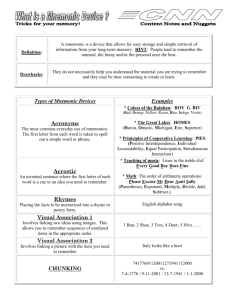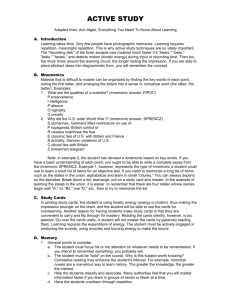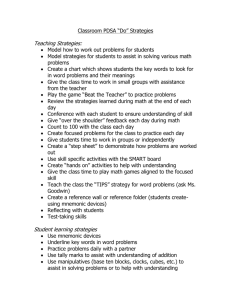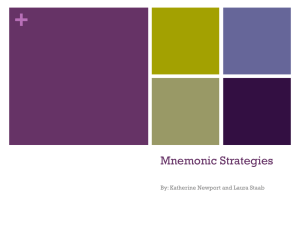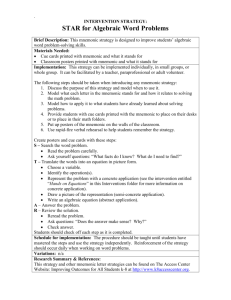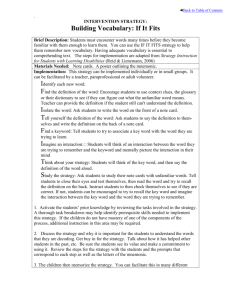Mnemonic Devices
advertisement
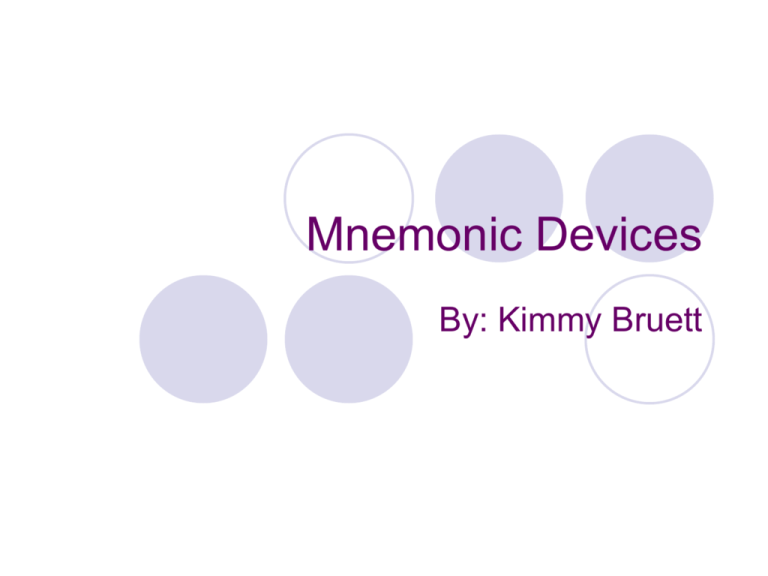
Mnemonic Devices By: Kimmy Bruett What Are Mnemonic Devices? According to library.thinkquest.org mnemonic devices are devices that people use to help them out in memorization. People use these to help them out for memorizing an array of things, basically anything. Examples: Visualization Rhyming Association Ect. Example PEMDAS: The P in please stands for parenthesis, the E in excuse stands for exponents, the M in my stands for multiplication, the D in dear stands for division, the A in aunts stands for addition, and the S in sally stands for subtraction. People use this to memorize the order of operations in solving a mathematical equation. Mnemonic Devices in memorization There are many different ways in which mnemonic devices come in handy. Here are a few of the different methods of mnemonic devices: Acronyms and acrostics Rhymes Imagery Method of Loci Number-letter system Peg-word system Acronyms and Acrostics According to LEARN by Regina G. Richards: Acronym is a word formed from the first letters or groups of letters in a name or phrase. Example: MVEMJSUNP = My Very Earnest Mother Just Served Us Nine Pickles = The colors of the rainbow, in order: Red, Orange, Yellow, Green, Blue, Indigo, Violet. Acrostic is a series of lines from which particular letters (such as the first letters of all lines) from a word or phrase. Example: HOMES stands for the Great Lakes, which would be Huron, Ontario, Michigan, Erie, Superior. Rhyme According to LEARN by Regina G. Richards: A rhyme is a saying that has similar distinctive sounds at the end of each line. Studies have shown that rhyming makes things easier to remember because it can be stored with acoustic encoding. Example: • In fourteen hundred and ninety-two Columbus sailed the Ocean Blue. • 30 Days has September, April, June, and November. All the rest have 31, except February. • "i" before "e," except after "c," or in sounding like "ay" as in "neighbor" or "weigh." Imagery According to LEARN by Regina G. Richards: Imagery is used to memorize pairs of words. An image is formed as a result of each word given, and then two images are joined through mental visualization. Example: Piggy bank= + = Method of Loci According to LEARN by Regina G. Richards: The Method of Loci is a mnemonic device that dates back to Ancient Greek times. They would use this to assist them when memorizing a speech. Example: You have to imagine a place that you are very familiar with. Then you imagine all the possible locations in that place, or all possible situations. It could help if you put everything in a specific order. • Say you were telling someone about a house. You would have to be very familiar with that house and everything in it. And in order to make telling someone about this house easier you would have to think about it in some kind of order. You could start at the basement, then move up to the main floor, and then move to the second floor. Peg-Word System According to LEARN by Regina G. Richards: The Peg-Word System can be used for memorizing an ordered list of words or the specific numbers associated with the words. Example: 1.bun 2.shoe 3.tree 4.door 5.hive 6.sticks 7.heaven 8.gate 9.line or shine or vine 10.hen Number-Letter System According to LEARN by Regina G. Richards: The Number-Letter System is very similar to the Peg- Word System, because it, too, is a method of association. The only difference is that this method allows you to remember things by associating them with similarities of the number it is at. Example: 1.= t (there is one downstroke in the letter t) 2.= n (there are two downstrokes in the letter n) 3.= m (there are three downstrokes in the letter m) 4.= r (the last letter in four is r) 5.= l (the Roman number 50 is L) 6.= sh (the word six has begins with an x) 7.= k (the number seven can be turned around to look like part of the letter k) 8.= f (a cursive f looks like an 8) 9.= p (a p flipped looks like a 9) 10.= z, s (think of zero) Bibliography Book: Richards, Regina G. LEARN Playful Techniques to Accelerate Learning. Tucson: Zephyr P, 1993. 1-173 Internet: "Mnemonic Devices." ThinkQuest.Org. 2005. 29 Oct. 2007 <http://library.thinkquest.org/C0110291/tricks/ mnemonics/index.php>.
